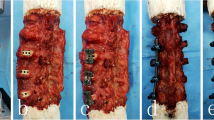Abstract
Anterior lumbar interbody fusion (ALIF) cages are expected to reduce segmental mobility. Current ALIF cages have different designs, suggesting differences in initial stability. The objective of this study was to compare the effect of different stand-alone ALIF cage constructs and cage-related features on initial segmental stability. Human multi-segmental specimens were tested intact and with an instrumented L3/4 disc level. Five different ALIF cages (I/F, BAK, TIS, SynCage, and ScrewCage) were tested non-destructively in axial rotation, flexion/extension and lateral bending. A cage ‘pull-out’ concluded testing. Changes in neutral zone (NZ) and range of motion (ROM) were analyzed. Cage-related measurements normalized to vertebral dimensions were used to predict NZ and ROM. No cage construct managed to reduce NZ. The BAK and TIS cages had the largest NZ increase in flexion/extension and lateral bending, respectively. Cages did reduce ROM in all loading directions. The TIS cage was the least effective in reducing the ROM in lateral bending. Cages with sharp teeth had higher ‘pull-out’ forces. Antero-posterior and medio-lateral cage dimensions, cage height and wedge angle were found to influence initial stability. The performance of stand-alone ALIF cage constructs generally increased the NZ in any loading direction, suggesting potential directions of initial segmental instability that may lead to permanent deformity. Differences between cages in flexion/extension and lateral bending NZ are attributed to the severity of geometrical cage-endplate surface mismatch. Stand-alone cage constructs reduced ROM effectively, but the residual ROM present indicates the presence of micromotion at the cage-endplate interface.
Similar content being viewed by others
Author information
Authors and Affiliations
Additional information
Received: 3 June 1999/Revised: 3 September 1999/Accepted: 8 September 1999
Rights and permissions
About this article
Cite this article
Tsantrizos, A., Andreou, A., Aebi, M. et al. Biomechanical stability of five stand-alone anterior lumbar interbody fusion constructs. E Spine J 9, 14–22 (2000). https://doi.org/10.1007/s005860050003
Issue Date:
DOI: https://doi.org/10.1007/s005860050003




